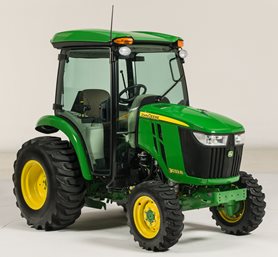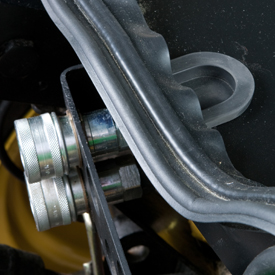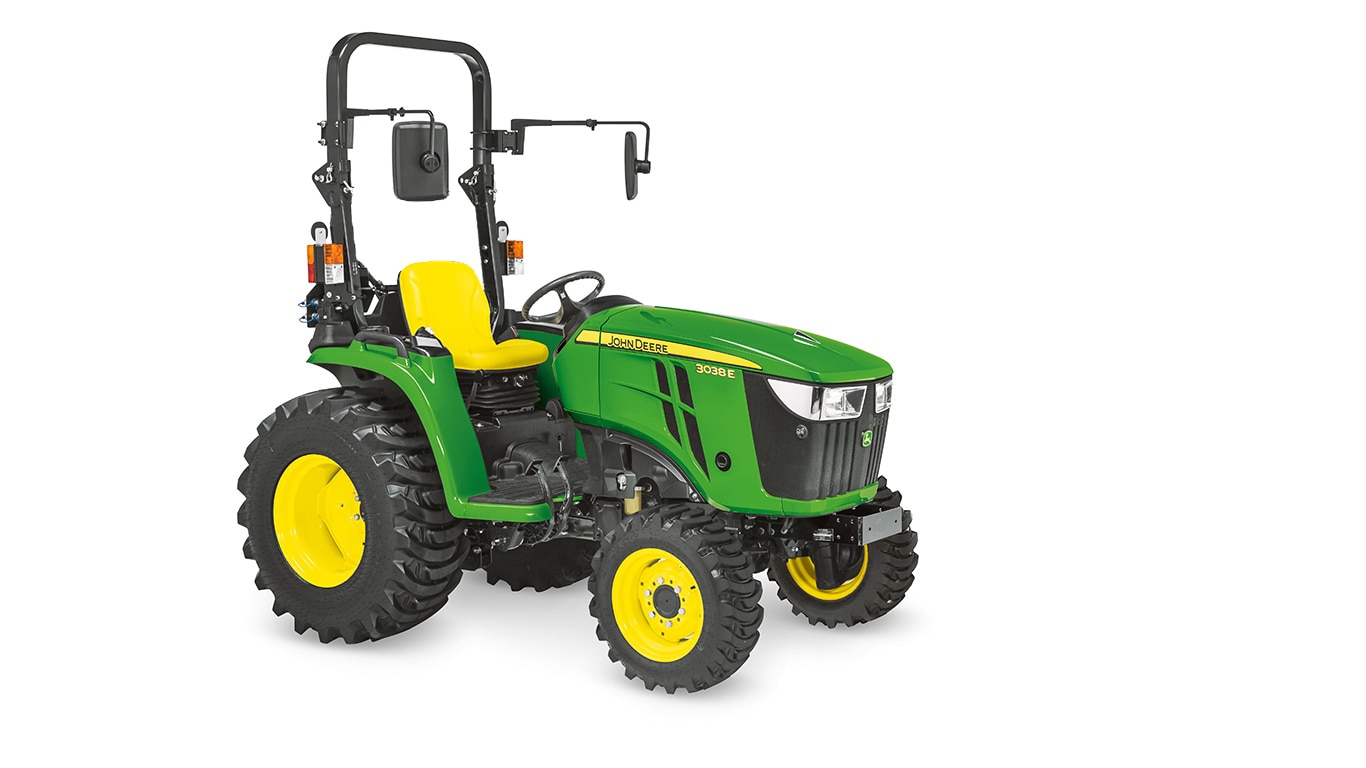 Yanmar 3-Cylinder, TNV Series diesel engine
Yanmar 3-Cylinder, TNV Series diesel engine
The Yanmar 3-cylinder, TNV series diesel engine features a high torque reserve that provides plenty of power under heavy loads.
This engine features lower levels of exhaust emissions and reduced noise levels. The engine meets all current Environmental Protection Agency (EPA) emission requirements for Final Tier 4 (FT4) emission standards.
3039R
The 1.496-L, turbocharged, 3TNV86CT CR Yanmar diesel engine provides 38.2 hp to the 3039R Tractor.
Model |
Number of
cylinders |
Engine
displacement |
Rated rpm |
Gross engine kW* |
Gross engine hp* |
PTO hp estimated* |
3039R |
3 |
1.496L |
2600 |
28.5 |
38.2 |
29.8 |
*Engine hp (kW), gross SAE J1995: 38.7 (28.5) at 2600 rpm, PS
Displacement, in3 (L): 95.7 (1.568)
3046R
The 1.496-L, turbocharged, intercooled 3TNV86CHT CR Yanmar diesel engine provides 44.7 hp to the 3046R Tractor.
Model |
Number of
cylinders |
Engine
displacement |
Rated rpm |
Gross engine kW* |
Gross engine hp* |
PTO hp* |
3046R |
3 |
1.496L |
2600 |
33.3 |
44.7 |
33.1 |
*Engine hp (kW), gross SAE J1995: 45.3 (33.34) at 2600 rpm, PS
Displacement, in3 (L): 91.3 (1.496)
The engine uses latest technologies to optimize fuel economy, improve control and accuracy, and reduces environmental impact.
The common rail system (CRS) optimizes fuel economy and reduces operating costs*. High pressure injection atomizes fuel into finer particles which burn more completely. It results in improved fuel economy and lower cost of operation.
The electronic control unit (ECU) provides optimum fuel control and accuracy. ECU monitors and controls the engine. It continuously monitors engine conditions and adjusts the fuel delivery accordingly to ensure optimum performance and emissions.
The engine comes with an aftertreatment system. The system operates automatically. The exhaust filter consists of a diesel particulate filter (DPF) which captures particulate matter (PM) contained in the exhaust gas. Using a natural cleaning process, most of the PM trapped in the exhaust filter is eliminated by the heat of the exhaust stream generated by normal use. In situations of low temperature, engine speed or load factor, an active cleaning cycle is initiated. In this cleaning cycle, the exhaust gas temperature is raised by injecting additional fuel during the exhaust stroke of normal vehicle operation to the diesel oxidation catalyst (DOC).
After many hours of use, the exhaust filter may require an ash removal service.
NOTE: *As compared to engines not using CRS technology.
DPF cleaning
Depending on the load that the tractor is under, as well as ambient temperature, humidity, and engine speed, the DPF may build up with particulate matter, thus requiring cleaning. Filter cleaning is determined by one of three conditions:
- A prescribed time-based estimation of needed filter cleaning
- DOC/DPF pressure sensors
- A particulate matter buildup estimation based on load conditions
Once one of the three conditions has been met, filter cleaning will occur.
There are three different types of filter cleaning processes:
- Passive filter cleaning
- Active filter cleaning
- Parked filter cleaning
Passive filter cleaning
Passive filter cleaning occurs naturally when the engine is generating enough heat to oxidize particulate matter. This automatic process occurs continuously during normal operating conditions. No tractor icons or symbols appear on the display during passive filter cleaning.
NOTE: Passive filter cleaning requires no operator involvement, and there is no interruption to tractor operation.
Active filter cleaning
If conditions (temperature, load, or speed) for passive filter cleaning cannot be achieved, then PM is removed using active filter cleaner.
To achieve the required conditions, exhaust temperature management (ETM) manages the initiation and duration of active filter cleaning. ETM can adjust numerous engine parameters and/or inject a small quantity of fuel into the exhaust stream for a short duration. The fuel turns to vapor and chemically reacts with the catalysts in the DOC to create heat to oxidize PM.
It is important to note that at no time is the fuel in the DOC/DPF ignited, and there is no flame within the DOC/DPF.
Like passive filter cleaning, active filter cleaning requires no operator involvement, and there is no interruption to tractor operation.
Parked filter cleaning
In some instances where passive and active filter cleaning have not fully cleaned the PM from the system, a parked filter cleaning may need to take place. Most likely, the only time a parked filter cleaning will need to occur is when automatic filter cleaning has been disabled for an extended period of time and multiple warnings to engage filter cleaning were ignored or if the tractor has been used during light load conditions. Additionally, when the automatic filter cleaning process has been deliberately interrupted multiple times, or if active filter cleaning has failed numerous times due to a failed component, a parked filter cleaning may be requested. In these rare instances the operator will have to park the tractor and start the filter cleaning process.
The parked filter cleaning process needs to be activated based on usage and operation of the tractor. The process will take approximately 30 minutes. See operator’s manual for more details.
This system constantly monitors the soot level of the tractor, making sure the tractor is always in peak performance condition. This ensures high performance at all times.
NOTE: Number of hours since last regeneration and soot level percentage viewable on LCD display.
NOTE: When the tractor is in a filter cleaning process at low speed or while parked and running, the exhaust will be routed through the vertical exhaust outlet. In all other cases, the exhaust will be routed through the downward exhaust outlet. This ensures minimal heat impact to operator.
Key features of the engine are:
- Economical cast-in-block cylinder design for good cooling and long life
- Direct fuel injection
- Improves starting
- Injects fuel directly on top of pistons for more efficient combustion
- Develops more horsepower per gallon of fuel than indirect injection engines
- Aluminum alloy pistons with built-in steel struts are lightweight to reduce connecting rod-bearing loads and provide good heat transfer characteristics
- Design permits tighter tolerances and neutralizes expansion of the piston, which reduces blow-by and noise from piston slap
- Top rings are higher on the piston and a thinner head gasket is used to greatly reduce the volume of unburned waste gases and increase combustion efficiency
- Timing gears and injector drive gears have a helical profile to reduce engine noise
- Auto-bleed fuel system
- There is no need to prime the system if the tractor runs out of fuel
- The system will self-prime the injection pump, lines and injectors, providing fast fuel recovery for easier starting
- Key start and shutoff eliminates fuel shutoff knob
- Electric solenoid shuts fuel supply off immediately when key is turned off
- Fuel filter with replaceable element
- Water separator
- See-through coolant recovery tank permits operator to check coolant level without removing radiator cap
- Sealed radiator compartment keeps trash and debris on outside of hood
 Dry-type air cleaner
Dry-type air cleaner
- Dry-type air cleaner with safety element and electronic air service indicator
- Electronic air restriction indicator alerts operator when air filter servicing is required
- Dual element design for added engine protection
- Easy to service
- Hybrid exhaust
- Discharges fumes away from the operator and reduces noise from engine
- Improves operator visibility
- Optional vertical exhaust kit is available
- In normal operations, the exhaust goes through the downward exhaust outlet
- In park regeneration process, the exhaust will go through the upward exhaust outlet
Yanmar is a trademark of Yanmar Company Limited.





























